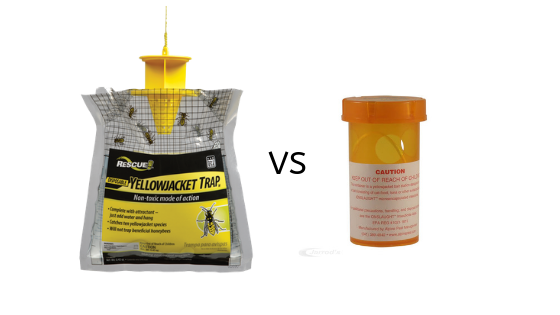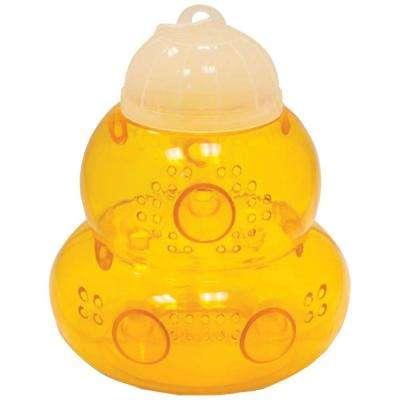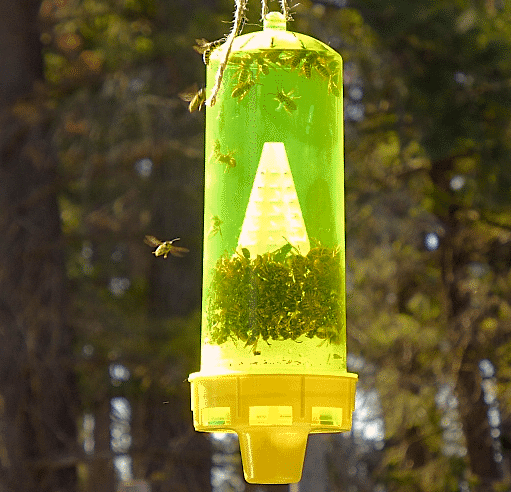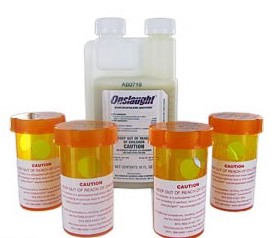Traps vs Bait Stations for Yellow Jacket Wasps
Posted

If you have a problem with Yellow Jacket wasps, you probably are researching ways to get rid of them. Two of the most common ways are hanging up either Yellow Jacket Traps or Yellow Jacket Bait Stations. Here’s a comparison on both. But first some background.
What are Yellow Jacket Wasp Traps?
Yellow Jacket traps are contraptions you can buy or build that trap and collect Yellow Jacket Wasps and other wasps such as Hornets. You can think of them as mini prisons. A trap usually is about the size of a 2 liter bottle of soda (in fact you can make one out of a 2 liter bottle of soda!). It has a bait or lure to attract yellow jackets, multiple holes for yellow jackets to enter the trap and a mechanism to permanently trap the yellow jackets inside once they are inside. Many traps have megaphone-shaped tubes for holes that are easy to enter and hard to exit and soapy water at the bottom where the wasps get stuck and drown.

The yellow jacket attractant is almost always a combination of Heptyl butyrate (which is a signal for yellow jackets in mating), some type of sugar (sugar water, apple juice, cider), and often a protein (like a piece of hot dog). Since Yellow jacket/Wasp/Hornet traps actually trap the yellow jackets inside, are almost always biologically organic and there is no need to use pesticides.
If successful the trap will lure the wasp inside where they will find it difficult to impossible to escape. You can see the success by seeing dead yellow jackets pile up or live ones frantically trying to escape/ A successful trap will trap hundreds of yellow jackets over the course of a few weeks.

The attractant wears out and sometimes the container fills up with dead yellow jackets so every few weeks you need to open the trap, empty out the stale (and often smelly) bait and dead yellow jackets, refill it with fresh bait and rehang it.
While they look like they are effective since they are filling up with wasps, most yellow jacket traps are only moderately effective in controlling yellow jacket populations. They are better at distracting yellow jackets away from your picnic table where you might be eating. Given each trap can catch about 150 yellow jackets before refilling and that yellow jacket nests on average have 3000-6000 wasps, each trap refill only captures about 2.5%-5% of one nest’s population. Also- not all yellow jackets are attracted to the trap. Some may avoid the trap and head for your food instead.
Pro’s of Using a trap:
- Organic. No use of pesticides
- Inexpensive (if you make your own. If you use a professional trap and attractant the costs can exceed $50 for a few traps)
- Can trap Hornets and other wasps besides yellow jackets
- Moderately effective.
- They can be used to kill queens in the Spring.
Cons of using a Trap:
- Not very effective (only captures 5% of a nest per trap).
- Kind of disgusting - Needs to be emptied frequently (involving removing stale bait and dealing with hundreds of dead yellow jackets).
- Eye Sore - Bags/bottles with hundreds of dead yellow jackets are hanging in the air for the majority of the summer.
- Needs to be refilled every 2 weeks throughout the season.
- Can be a bit dangerous if you need to empty the trap while the attractant is still active.
What are Yellow Jacket Bait Stations?
Unlike traps, Yellow Jacket bait stations do not try to trap wasps inside a container. Instead they can destroy a nest from afar using a container that holds a bait treated with a very small amount of insecticide (usually drops of an already diluted delayed-action insecticide like Onslaught mixed into a protein like chicken or fish). You can purchase a full kit with Onslaught that includes 16oz of concentrated Onslaught that needs to be diluted and two bait stations, or buy individual stations separately.

To activate a yellow jacket bait station, you mix together the meat and insecticide and hang it (like you would a trap).
Once hung and activated, Yellow Jacket Wasps enter the bait station, grab the treated bait and then exit the container, taking the bait to their nest. Since the insecticide is delayed, the yellow jacket may enter and exit the bait station multiple times before the poison starts taking effect. Eventually the yellow jackets inside the nest (including the queen and larvae) feast on the treated meat and are killed by the insecticide.
When used effectively and if close enough to the nest, one bait station can destroy an entire nest of yellow jackets in 48 hours.
Unlike traps, bait stations are smaller and are removed after a few days. You therefore do not have to see bags/bottles of dead yellow jackets nor empty/deal with yellow jacket carcasses.
Bait stations do have their limitations:
First, unlike traps, bait stations do use insecticides. However, while a bait station uses insecticide, in almost all cases, the insecticide specifically targets mechanisms that occur naturally in insects and not mammals. Also, the bait station is hung inside a container for a few days and then removed and disposed of so the risk of exposure is pretty low.
Second, the only pesticide approved to be used in bait stations, Onslaught, is effective only for certain sub-species. In particular, it does not work well with Yellow Jackets in the west coast.
Third, bait stations only work during the earlier summer season (July/Sept) when yellow jackets search after meat. They are not effective in the spring (to catch queens) or in the fall (when yellow jackets go after sweets). They also only target yellow jackets do are not effective against hornets and other wasps.
Here are the full pro’s and cons:
Pros of using a Yellow Jacket Bait Station:
- Very effective: Can destroy an entire yellow jacket nest in a short amount of time.
- Does not need to be refilled every two weeks. Hang for 24 hours and the problem can go away for the summer.
- Relatively safe to use (just mix and hang).
- Not an eyesore (i.e. you do not see dead yellow jackets)
Cons of using Yellow Jacket Bait Stations:
- Not Organic: They use a pesticide (usually Onslaught).
- Can be more expensive than traps (full kits with 16oz of concentrated Onslaught and two bait stations cost around $120, while individual stations cost about $13)
- Main pesticide approved by EPA is not effective for all yellow jacket sub-species, particularly not with Western yellowjackets.
- Only works on yellow jackets and not Hornets
- Only works July-Sept
Should you use a Yellow Jacket Trap or Yellow Jacket Bait Station?
You now know the differences between traps and bait stations. So which should you use? If you have a bad yellow jacket problem where the wasps are coming after your grilled food and you just want it to go away - use a bait station. It is the most effective way to get rid of the wasps. We also recommend using a bait station if you have kids and really don’t want them to be stung.
If you have a minor problem, are looking in October, or really care about only having organic solutions, use traps. They might not get rid of your problem but they’ll help reduce the population and at least you can count how many you’ve killed.